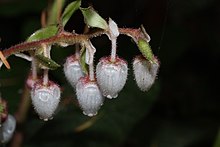Gaultheria shallon
| Gaultheria shallon | |
|---|---|
 |
|
| Scientific classification | |
| Kingdom: | Plantae |
| (unranked): | Angiosperms |
| (unranked): | Eudicots |
| (unranked): | Asterids |
| Order: | Ericales |
| Family: | Ericaceae |
| Genus: | Gaultheria |
| Species: | G. shallon |
| Binomial name | |
|
Gaultheria shallon Pursh |
|
Gaultheria shallon is a leathery-leaved shrub in the heather family (Ericaceae), native to western North America. In English, it is known as salal, shallon, or simply gaultheria in Britain.
G. shallon is 0.2 to 5 m (0.66 to 16.40 ft) tall, sprawling to erect. Evergreen, its thick, tough, egg-shaped leaves are shiny and dark green on the upper surface, and rough and lighter green on the lower. Each finely and sharply serrate leaf is 5 to 10 cm (2.0 to 3.9 in) long. The inflorescence consists of a bracteate raceme, one-sided, with five to 15 flowers at the ends of branches. Each flower is composed of a deeply five-parted, glandular-haired calyx and an urn-shaped pink to white, glandular to hairy, five-lobed corolla, 7 to 10 mm (0.28 to 0.39 in) long. The reddish to blue, rough-surfaced, hairy, nearly spherical fruit is 6 to 10 mm (0.24 to 0.39 in) in diameter.
G. shallon is tolerant of both sunny and shady conditions at low to moderate elevations. It is a common coniferous forest understory species and may dominate large areas with its spreading rhizomes. In coastal areas, it may form dense, nearly impenetrable thickets. It grows as far north as Baranof Island, Alaska.Western poison oak is a common associate in the California Coast Ranges.
Its dark blue berries and young leaves are both edible and are efficient appetite suppressants, both with a unique flavor. G. shallon berries were a significant food resource for native people, who ate them fresh and dried them into cakes. They were also used as a sweetener, and the Haida used them to thicken salmon eggs. The leaves of the plant were also sometimes used to flavor fish soup.
More recently, G. shallon berries are used locally in jams, preserves, and pies. They are often combined with Oregon-grape because the tartness of the latter is partially masked by the mild sweetness of G. shallon.
...
Wikipedia
